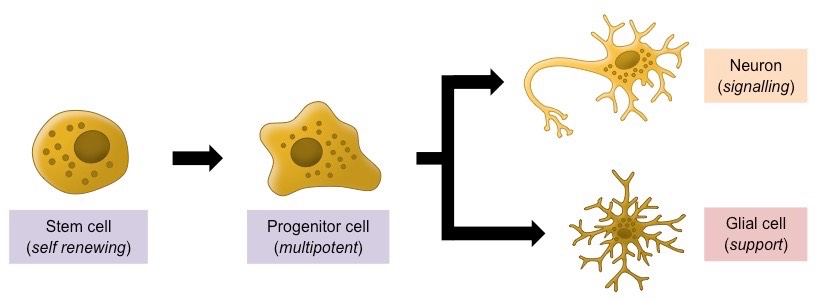![]()
Understanding:
• Neurons are initially produced by differentiation in the neural tube
The neural tube contains multipotent neuronal stem cells which can differentiate to form the different types of nerve cells:
- Neurons are specialised nerve cells that conduct messages – they can be sensory, motor or relay (interneurons)
- Glial cells provide physical and nutritional support for the neurons – roughly 90% of nerve cells in the brain are glial cells
Neurons are produced by progenitor neuroblasts via a process known as neurogenesis
- Most neurons survive for the lifetime of the individual and do not proliferate following embryogenesis (they are 'post-mitotic’)
- Certain brain regions may be capable of adult neurogenesis, but most of the nervous system is incapable of regeneration
Neuron Production via Neurogenesis

![]()
Understanding:
• Immature neurons migrate to a final location
Immature neurons must migrate in order to adopt precise final positions that allow for the formation of neural circuitries
- This migration process is critical for the development of brain and spinal architecture
Neural migration may occur via one of two distinct processes – glial guidance or somal translocation
- Glial cells may provide a scaffolding network along which an immature neuron can be directed to its final location
- Alternatively, the neuron may form an extension at the cell’s perimeter and then translocate its soma along this length
Mechanisms of Neural Migration
![]()
Understanding:
• An axon grows from each immature neuron in response to chemical stimuli
• Some axons extend beyond the neural tube to reach other parts of the body
An immature neuron consists of a cell body (soma) containing a nucleus and cytoplasm
- Axons and dendrites will grow from each immature neuron in response to chemical signals from surrounding cells
- Some axons may be quite short (within the CNS) but others may extend to other parts of the body (within the PNS)
An axon has a growth cone at its tip that contains highly motile growth filaments called filipodia
- Extension of these filipodia causes the expansion of the internal cytoskeleton within the growth cone – resulting in growth
- The direction of this expansion is controlled by chemical stimuli released from surrounding cells
- These cells may release chemoattractant signals (grow towards) or chemorepellant signals (grow away)
- Using these molecular guidance signals, axon growth cones may navigate long distances to reach specific targets
Axon Guidance by Chemical Signals

